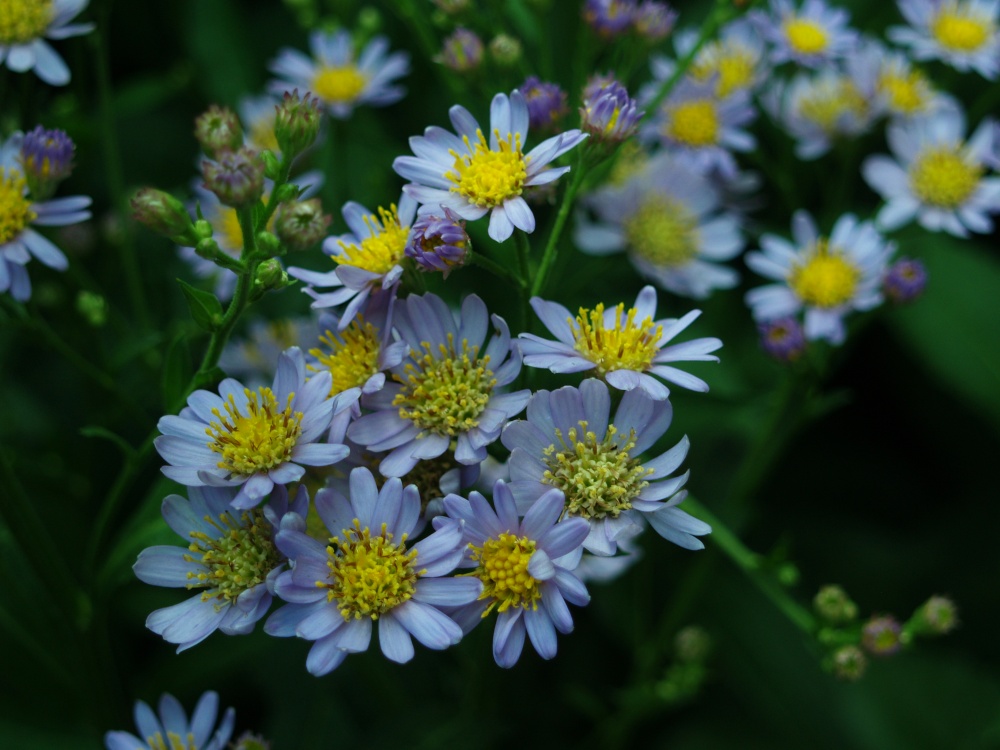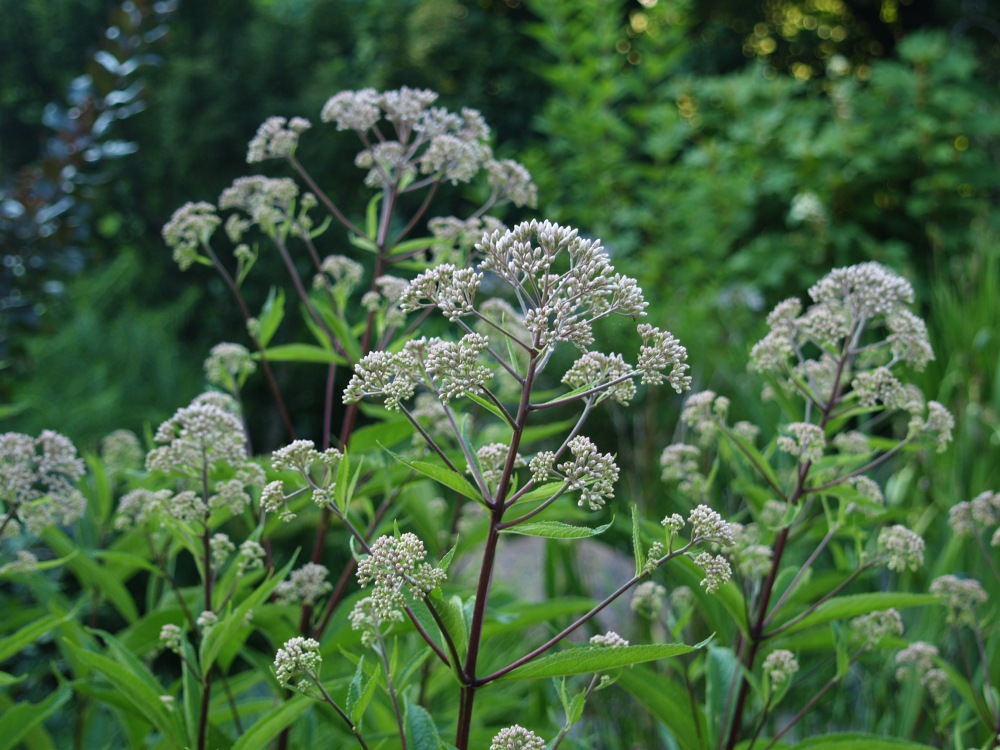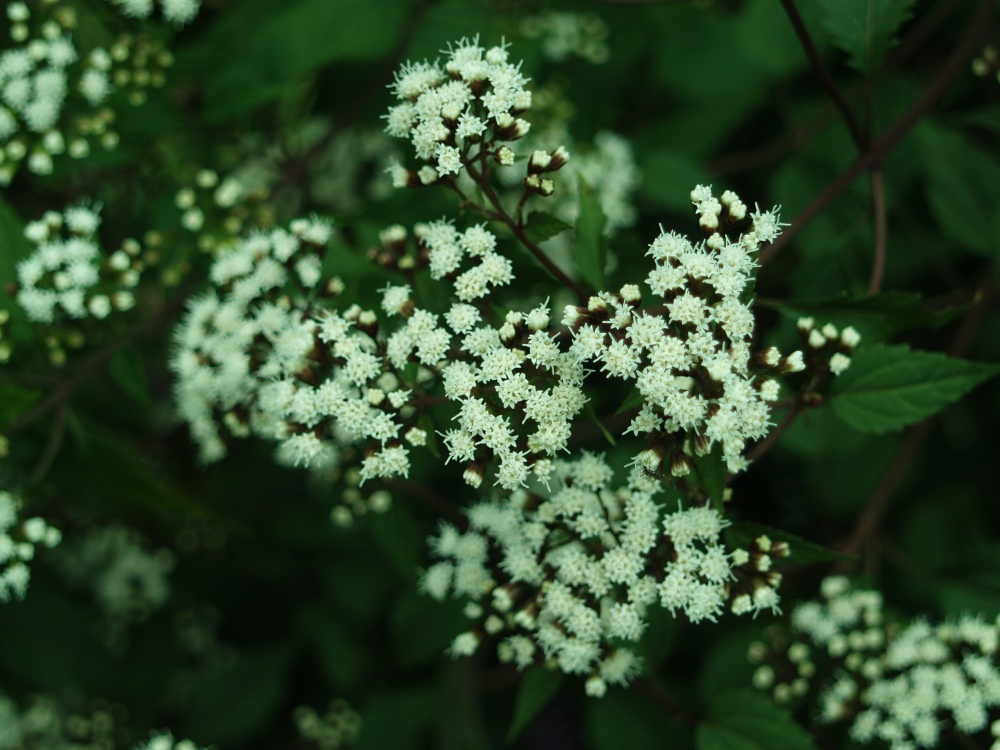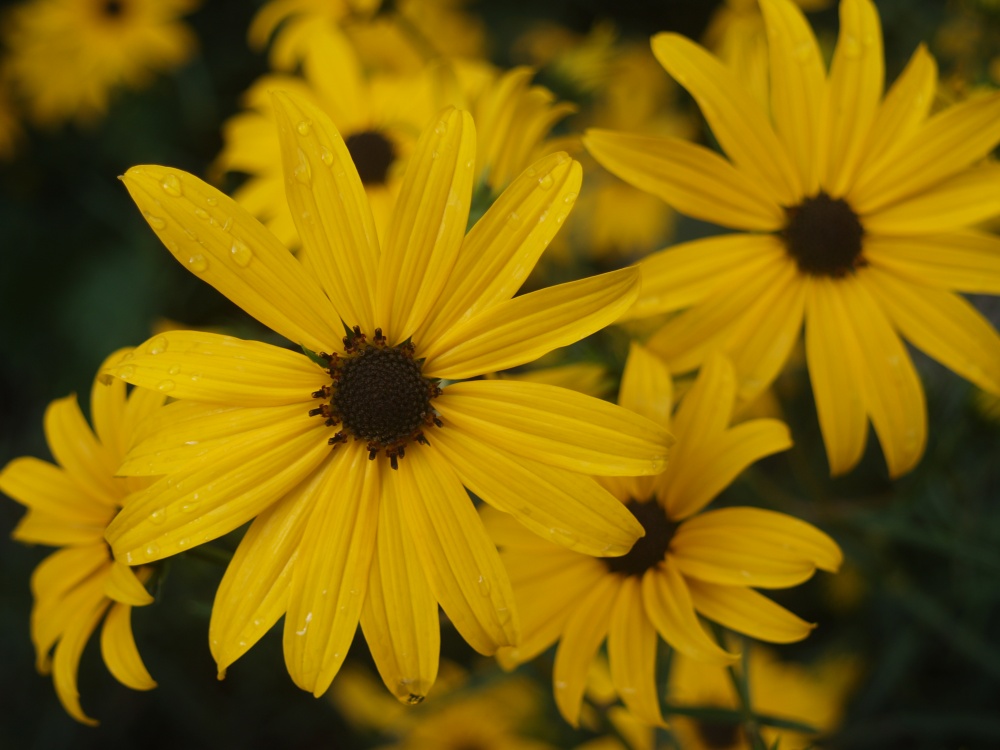No, not me. Tatarian daisy is a tough and beautiful perennial that shines in the early autumn garden.
‘Jindai’ Tatarian daisy (Aster tataricus ‘Jindai’, below) grows nearly five feet tall, but it’s habit is more compact and a few feet shorter than other Tatarian daisies (really Asters, but this is the hazard of common names). In small gardens a tall growing perennial might be out of scale, but in my garden I’m bothered today that it barely stands above its neighbors. In past years I was able to easily negotiate a path around shrubs and perennials to enjoy the large clusters of small blue daisy-like flowers at close range, but now edgeworthia and hydrangeas have grown much wider so that the only path to enjoy the aster is by straddling treacherous, wet and mossy boulders that border the large swimming pond.
In years past I visited ‘Jindai’ nearly every day while it flowered in September and October, but with difficult access I’ll brave it only a time or two each week. From across the pond I can see that the aster is nearly at full bloom, with handfuls of bumblebees buzzing about, and in another ten days there will be dozens feasting on its nectar when ‘Jindai’ reaches peak bloom.
‘Jindai’ is quite upright in habit, with large, coarsely textured foliage. It will spread a bit, but barely, and never too much to be a problem. It’s not finicky at all about soil, but the more sun it’s growing in the happier it will be. Though ‘Jindai’ is content in my garden for today tucked closely beside large shrubs, this is a fight it will lose, so I’ll be looking to transplant one or two of the three large clumps before they are overwhelmed.
‘Little Joe’ Joe Pye weed (Eutrochium purpureum, formerly Eupatorium, above) is also shorter and more compact than the native species that grows well over six feet tall in the swampy meadow at the back of the garden. While the tall native sets a handful of lavender flower heads, ‘Little Joe’ grows a dozen or more (even on young plants), and at four feet tall butterflies and bees that visit can be enjoyed at eye level. The foliage of Joe Pye weeds is coarsely textured and dark green, but not terribly exciting before flowering begins in mid summer. Joe Pye is vigorous and pest free, will grow in full sun or partial shade, and easily tolerates wet and dry soils.
‘Chocolate’ Joe Pye (Eupatorium rugosum ‘Chocolate’, above) is considerably shorter than ‘Little Joe’, but with a similar upright habit. The foliage is dark enough in color to earn the ‘Chocolate’ moniker and more ornamental than the native Joe Pye. The flowers are clusters of small white blooms, smaller than the lavender flowered native, and less persistent but still delightful for several weeks in early autumn. They flower too late in late September for butterflies, and I rarely see bees of any sort visiting the blooms. ‘Chocolate’ tends to seed itself about a bit, but never so that it’s a nuisance. The seedlings will show slight differences in the darkness of the foliage, but all are similar in habit, and I welcome seedlings that sprout in just about any shady area of the garden.
Missing from the garden this year are the tall perennial sunflowers that were finally overwhelmed by the same edgeworthia that threatens the ‘Jindai’ aster. I was supposed to transplant the sunflowers, but typically didn’t get around to it, and now they’re gone.
I was not quite so enamored with the sunflowers as I’ve been with the tall asters. They were tall and floppy, even when deer were not parading through and nearly flattening them (which is the consequence of planting in the middle of a frequently traveled deer trail between my garden and the neighbor’s vegetables). With fewer sunny spots available in the garden each year as trees grow taller and wider, I am not likely to replant the sunflowers, but for blazing hot and dry soils these are wonderful and sturdy perennials. In damp soils they will grow vigorously, but will become more floppy.
In my everlasting war on flopping plants I have also embraced the tartarian aster and ‘Little Joe’. The tartarian is probably close to six feet tall and like yours, full of pollinators. I found the native Joe pye to be a wilter on hot afternoons(alas, I don’t have a awamp) but ‘Little Joe’ does just fine. Chocolate joe pye tended to flop for me. I am really trying to get away from plants that need orthopedic assistance . Annabelle hydrangea is being moved away friom the house because of her tendency to go flat after rain (it doesn’t take much).
I have a garden full of floppers, so I don’t mind ‘Chocolate’ at all. Annabelle hydrangea is too much, even for me. It flops when it’s dry, and when wet it nearly flattens to the ground. Paniculata hydrangeas are far superior with equally large blooms and stiffer stems.